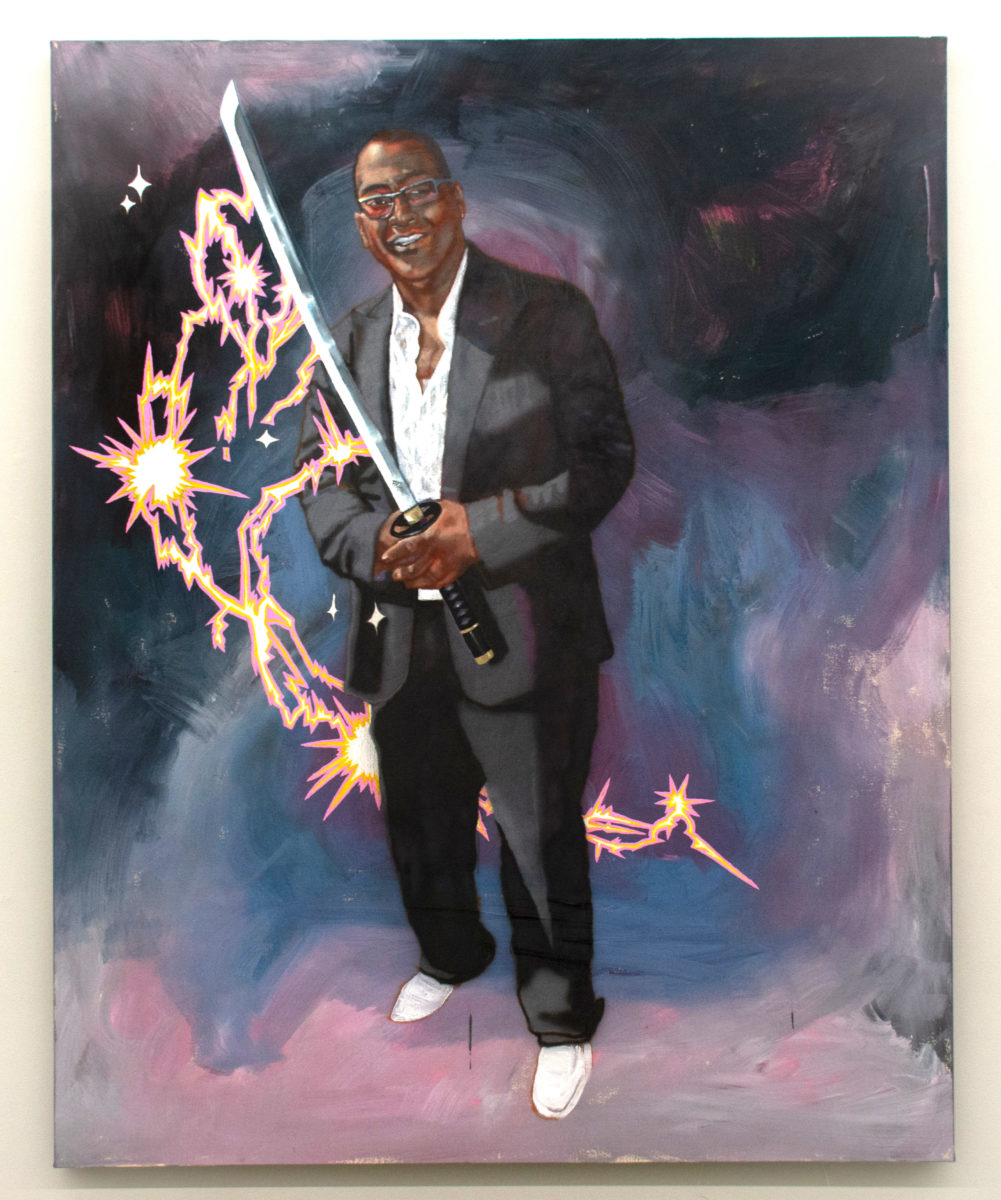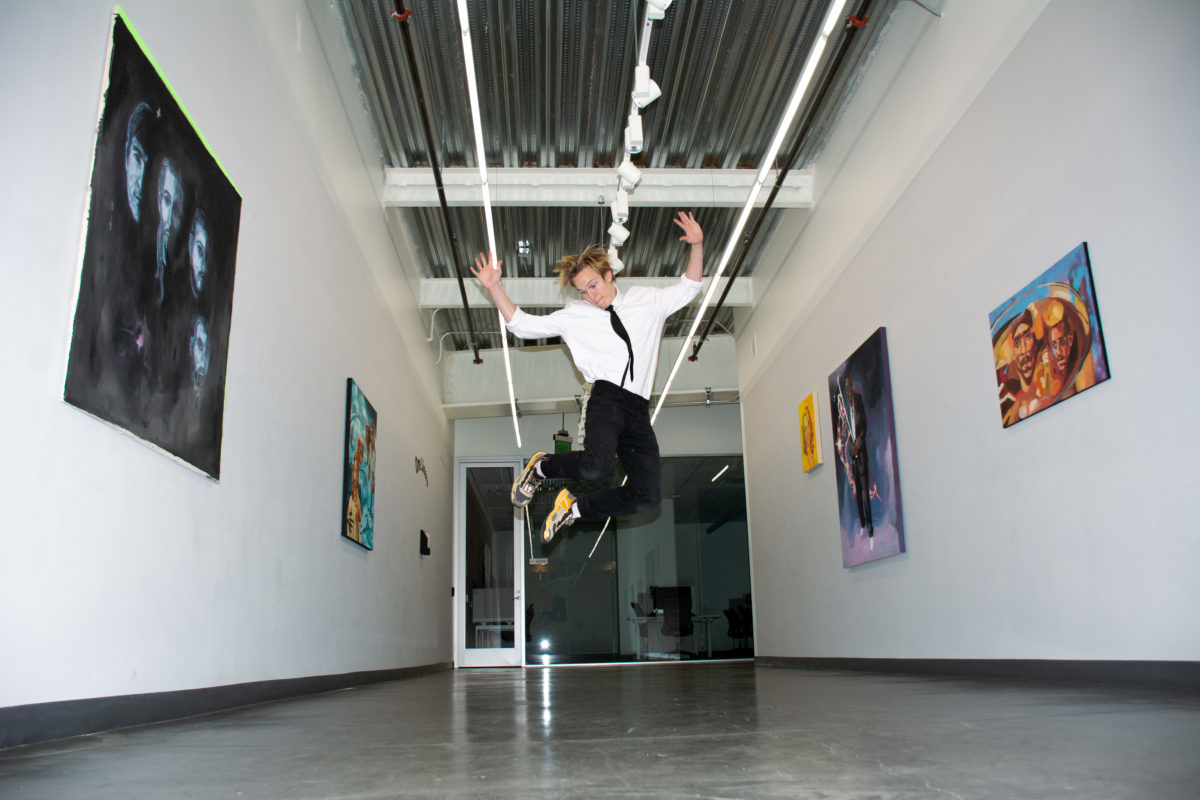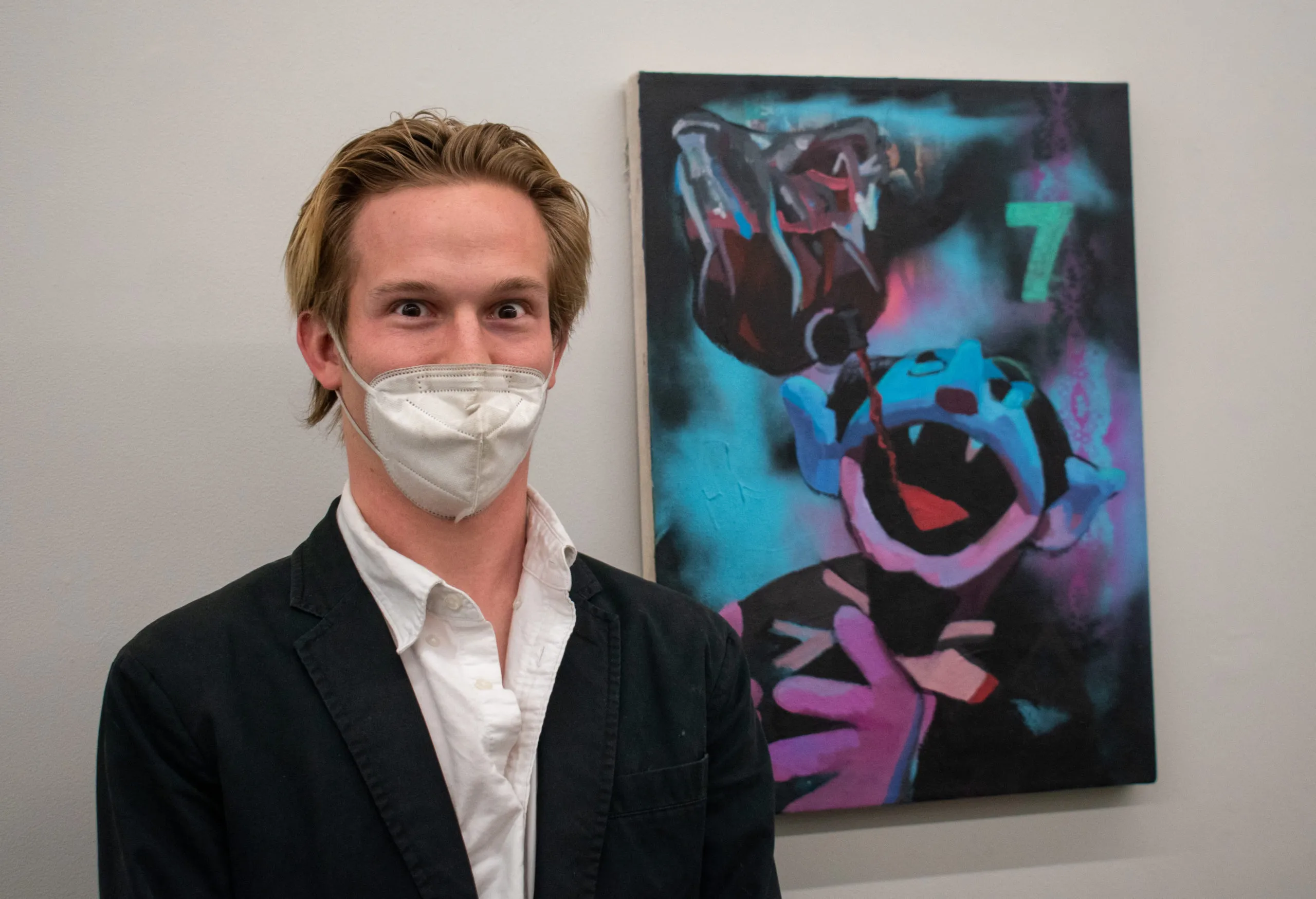“Why is this one locked up?” Kyla Figueroa ’24 asked me as we stared intently at one of the exhibits at Mohr Gallery on Tuesday evening.
“Well…” I hesitated, “It’s Nicolas Cage. In a cage.”
There was a pause as she registered the joke before laughing in earnest. I began to laugh too as she shook her head at the pun.
“Nicolas Caged,” an airbrushed portrait of Nicolas Cage behind a window guard, is just one of Gunner Dongieux’s ’21 seven tongue-in-cheek artworks currently on display as “One Liners.” Each work materializes a one-line cultural pun, and many of them are acerbic comments on the cartoonish features of our zeitgeist. Dongieux is on track to complete his honors in art practice. His works explore the uncanny and the absurd — irreverence as a strategy of criticism and laughter as a strategy of processing.
“Matthew, Mark. Luke and John” hung across the room from “Nicolas Caged.” Featuring four pale specters fading into the sooty black background, the painting was grim, mythological and sardonic. Clearly referencing The Beatles’ 1963 album cover, it mocked the deification of flawed pop icons by juxtaposing John Lennon with the Hellenistic depiction of the apostles. What struck me were the small stickers of doves across the otherwise consistent dimensions of the painting — little disclosures of Dongieux’s strongly absurdist leanings.
When asked about the stickers, Dongieux said, “I was interested in including stickers in my formal language as an artist because of the way they accentuate the absurdity and sort of pop out.” The artist also used stickers in his painting “Ancient Aliens,” which features stickers of Boots from “Dora the Explorer.”
“Ancient Aliens” sets Jesus Christ next to E.T. in reference to conspiracy theories linking Jesus with ancient aliens. The work made me think of graffiti with its spray-painted, highly-saturated tidal blues and thick outlines.
“His process is fascinating,” said Nicko Rucker ’21, who was Dongieux’s roommate in New York last year and witnessed the creation of “Ancient Aliens.” “I’ve seen him begin with rabbit-holing down Google Images and choreographing all these connections, almost like iPhoto memories montages. And to see the final product after that is just so crazy. Art can be really serious, but this collection is so fun. It makes me laugh, and I really value that.”
Dongieux said he was originally interested in more traditional art forms: his oeuvre largely consisted of self-portraiture and narrative scenes set in New Orleans from the perspective of teenage Odysseus. During college, his interest shifted towards the uncanny and the absurd. “That shift is simply a reflection of how I perceive the world. My concept of the world used to be a lot cleaner, and now it’s a lot more chaotic,” Dongieux said. He is interested in his own and others’ inability to process the cultural moment. Dongieux takes inspiration from the absurdist strategies of art practice professor Enrique Chagoya, Mike Kelley and Mathieu Malouf.
A popular favorite at Tuesday’s show was “Iced Tea,” two portraits of Ice-T, rapper and star of “Law and Order: Special Victims Unit,” floating on top of a glass of ice tea. Nicha Rattanabut ’24 appreciated the pronounced colors and brush strokes in the painting. “This show makes me want to be more aware of pop culture trivia,” she joked. Even at this level of surreal abstraction, there is stern realism to the portrait’s expressions.

Dongieux said “Judge, Jury and Executioner” was his favorite piece of the show. The painting depicted Randy Jackson wielding a signed samurai sword, a reference to the slapstick comedy “Step Brothers.” Started in the fall, it was the longest project in the collection. “I think the others are truly one-liners in a sense, but this one has a lot of conceptual depth about judgment and our ideas about judgment,” Dongieux said. The airbrush work, the classically painted face and the painstakingly fine pop outlines make the work intensive to analyze. The subject emerges out of the background with startling dimension, an effect that is further textured by the electric crackle pop art.
In contrast, ”Liz Lemon,” an airbrushed portrait of Tina Fey with a Lisa Franklin illustration under her face, took only a day to complete. It is hot colored, with loud assertions of thick yellows and oranges. In “Slap The Bag,” Count Von Count, a muppet from Sesame Street, guzzles a stream of Franzia boxed wine, referencing the popular drinking game with the count down “10, 9, 8, 7, 7, …”
“I was thinking of all-campus parties in this one,” Dongieux said of “Slap The Bag.” “You know those intense flash photographs in which all you can see is the subject and you have a sense of the crowd behind it?” I peered at the canvas, and indeed, in collage-style camouflage there was a hint of a crowd layered beneath the acrylics and spray paint.

I’d entered the show wary of postmodernism’s antiheroic cynicism and contempt. Camille Paglia describes “self-cannibalizing pop, with its signature sampling and retro fads” as “often distanced through a protective pose of nervous irony.” Dongieux’s works, however, confidently circumvent the New Sincerity campaign, possessing an almost post-ironic tone. There is nothing nervous about the art pieces, and they certainly aren’t distanced — they are inviting and hilarious, deeply vital and exciting to talk about. Though they are dark in their humor, there is something pleasantly intimate about co-experiencing cultural disorientation via laughter.
“I really enjoy how they are critical without being despairing, and how he resuscitates mythological effects in some of them,” Alessandra Portinari ’24 said.
The room whirred with conversation and movement as people drifted around the venue. The little Bluetooth in the corner hummed with indie-rock music. I slipped out quietly — it was a pun time.
Editor’s Note: This article is a review and includes subjective opinions, thoughts and critiques.
